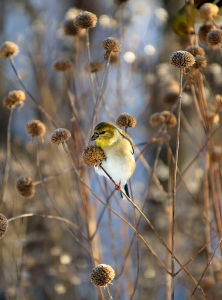
By Andy McGlashen, Audubon Magazine
October 06, 2017
A manicured lawn might look nice, but messy is better for birds and bugs.
There’s a certain satisfaction in autumn chores. When the weather’s right, cleaning gutters, touching up paint, or splitting some firewood can feel less like manual labor and more like a rite of the season.
But if you want to make your backyard a welcoming winter haven for birds, some fall tasks call for a laissez-faire approach. “Messy is definitely good to provide food and shelter for birds during the cold winter months,” says Tod Winston, Audubon’s Plants for Birds program manager.
So let someone else keep up with the neighbors this weekend. Sleep in, linger a little longer with your morning coffee, and follow these tips for a bird-friendly yard you can be proud of.
Save the seeds. When fall arrives, some tidy-minded gardeners might be inclined to snip the stems of perennials in the flower garden. But the seed heads of coneflowers, black-eyed Susans, and other native wildflowers provide a helpful food cache for birds. “They’re almost invisible, those seeds, but birds eat them all winter long,” Winston says. Grasses—not the stuff you mow, but native species like bluestems or gramas—also make for good foraging after they go to seed. And letting other dead plants stick around can fill your property with protein-packed bird snacks in the form of insect larvae, such as the fly and wasp larvae that inhabit goldenrod galls.
Leave the leaves. You can help birds and other wildlife—and save yourself some backache and blisters—by skipping the leaf raking. “Those leaves are important because they rot and enrich the soil, and also provide places for bugs and birds to forage for food,” Winston says. If a fully hands-off approach doesn’t work for your yard, consider composting some leaves and letting the rest be. You could also rake them from the lawn to your garden beds, or mulch them with a mower to nourish your lawn.
Leaf litter isn’t just free fertilizer—it’s also a pretty happening patch of habitat for a variety of critters such as salamanders, snails, worms, and toads. “If you’re digging in the garden and come upon these squirmy little coppery-brown dudes, and you don’t know what they are—those are moth pupae,” Winston says. A healthy layer of undisturbed soil and leaf litter means more moths, which in their caterpillar phase are a crucial food source for birds.
Leave native perennials standing until spring and their seed heads will provide nutrition for birds, like this American Goldfinch nibbling on bergamot seeds. Photo: Ross Frid/Alamy
Build a brush pile. Along with shaking loose showers of leaves, blustery fall days also tend to knock down tree limbs. Rather than hauling them away, you can use fallen branches to build a brush pile that will shelter birds from lousy weather and predators. American Tree Sparrows, Black-capped Chickadees, and other wintering birds will appreciate the protection from the elements. Rabbits, snakes, and other wildlife also will take refuge there. You’ll find that the pile settles and decomposes over the seasons ahead, making room for next year’s additions. (And it’s a great place to dispose of your Christmas tree.)
Skip the chemicals. You might see your neighbors spreading “weed and feed” mixtures in the fall to fertilize their lawns and knock back crabgrass and other unwanted plants. In most cases, though, grass clippings and mulched leaf litter provide plenty of plant nutrition, and using store-bought fertilizers only encourages more non-native plants to grow. Generally speaking, native grasses, shrubs, trees, and flowering plants don’t need chemical inputs. Save a few bucks and keep your yard healthy for bugs and birds.
Hit the nursery. Although laziness can be a good thing when it comes to creating a bird-friendly backyard, it’s worth putting in some hard work planting native shrubs and trees. (Cooler temperatures also make fall a more comfortable time to tear out some turf grass and expand your native plant garden.) Native dogwoods, hawthorns, sumacs, and other flowering shrubs produce small fruits that not only feed birds during the colder months, but can also provide a welcome pop of color when winter gets drab. Planted in the right place, evergreens like cedars and firs give birds something to eat and a cozy shelter. Fall is also a great time to liven up your property with late-blooming perennials such as asters or sages—and to buy spring- and summer-blooming wildflowers at a substantial discount.
To find species suited to your yard, just enter your ZIP code in Audubon’s native plants database. If you plant trees or shrubs this fall, they might not bear fruit this year—but come next winter, you and your backyard birds will be glad you did.







